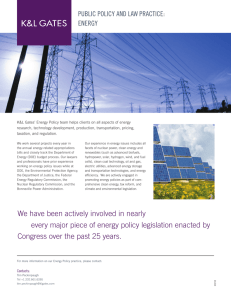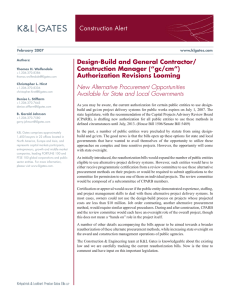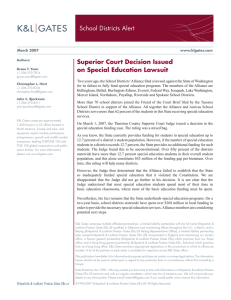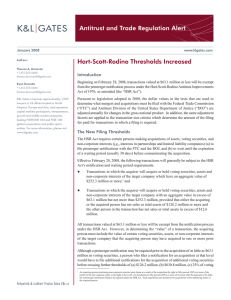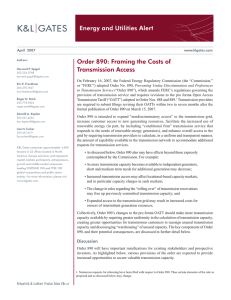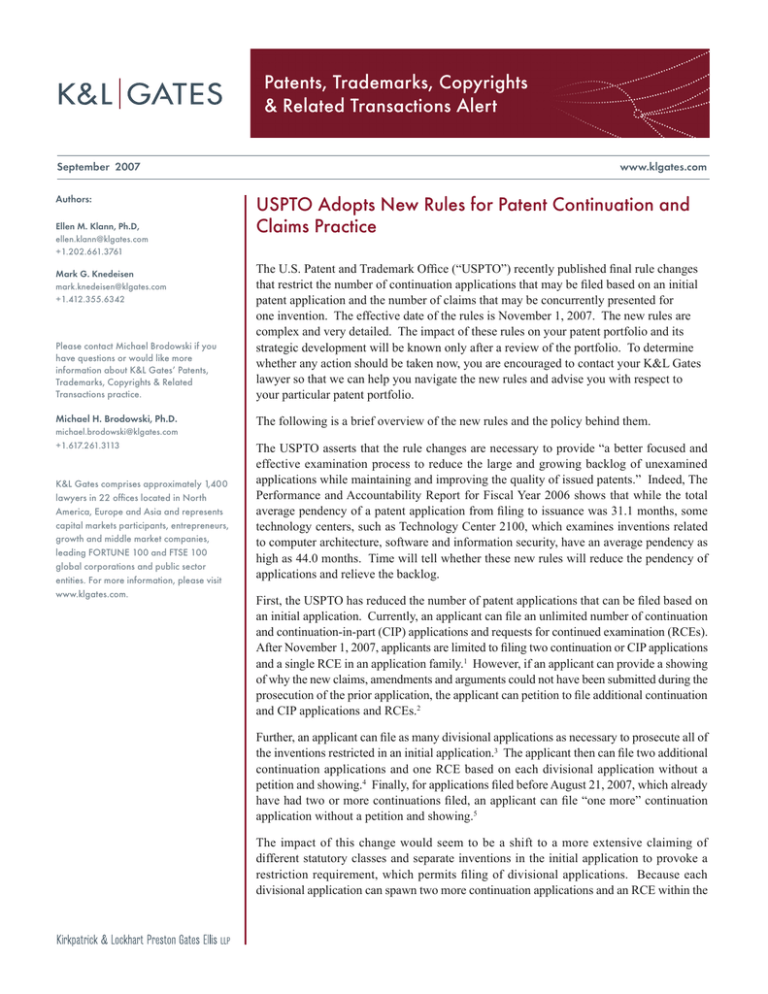
Patents, Trademarks, Copyrights
& Related Transactions Alert
September 2007
www.klgates.com
Authors:
Ellen M. Klann, Ph.D,
ellen.klann@klgates.com
+1.202.661.3761
USPTO Adopts New Rules for Patent Continuation and
Claims Practice
Please contact Michael Brodowski if you
have questions or would like more
information about K&L Gates’ Patents,
Trademarks, Copyrights & Related
Transactions practice.
The U.S. Patent and Trademark Office (“USPTO”) recently published final rule changes
that restrict the number of continuation applications that may be filed based on an initial
patent application and the number of claims that may be concurrently presented for
one invention. The effective date of the rules is November 1, 2007. The new rules are
complex and very detailed. The impact of these rules on your patent portfolio and its
strategic development will be known only after a review of the portfolio. To determine
whether any action should be taken now, you are encouraged to contact your K&L Gates
lawyer so that we can help you navigate the new rules and advise you with respect to
your particular patent portfolio.
Michael H. Brodowski, Ph.D. The following is a brief overview of the new rules and the policy behind them.
Mark G. Knedeisen
mark.knedeisen@klgates.com
+1.412.355.6342
michael.brodowski@klgates.com
+1.617.261.3113
K&L Gates comprises approximately 1,400
lawyers in 22 offices located in North
America, Europe and Asia and represents
capital markets participants, entrepreneurs,
growth and middle market companies,
leading FORTUNE 100 and FTSE 100
global corporations and public sector
entities. For more information, please visit
www.klgates.com.
The USPTO asserts that the rule changes are necessary to provide “a better focused and
effective examination process to reduce the large and growing backlog of unexamined
applications while maintaining and improving the quality of issued patents.” Indeed, The
Performance and Accountability Report for Fiscal Year 2006 shows that while the total
average pendency of a patent application from filing to issuance was 31.1 months, some
technology centers, such as Technology Center 2100, which examines inventions related
to computer architecture, software and information security, have an average pendency as
high as 44.0 months. Time will tell whether these new rules will reduce the pendency of
applications and relieve the backlog.
First, the USPTO has reduced the number of patent applications that can be filed based on
an initial application. Currently, an applicant can file an unlimited number of continuation
and continuation-in-part (CIP) applications and requests for continued examination (RCEs).
After November 1, 2007, applicants are limited to filing two continuation or CIP applications
and a single RCE in an application family.1 However, if an applicant can provide a showing
of why the new claims, amendments and arguments could not have been submitted during the
prosecution of the prior application, the applicant can petition to file additional continuation
and CIP applications and RCEs.2
Further, an applicant can file as many divisional applications as necessary to prosecute all of
the inventions restricted in an initial application.3 The applicant then can file two additional
continuation applications and one RCE based on each divisional application without a
petition and showing.4 Finally, for applications filed before August 21, 2007, which already
have had two or more continuations filed, an applicant can file “one more” continuation
application without a petition and showing.5
The impact of this change would seem to be a shift to a more extensive claiming of
different statutory classes and separate inventions in the initial application to provoke a
restriction requirement, which permits filing of divisional applications. Because each
divisional application can spawn two more continuation applications and an RCE within the
Patents, Trademarks, Copyrights
& Related Transactions Alert
divisional application family, additional opportunities
to issue patents will be available. Moreover, to pursue
aggressively patent protection in each application,
interviewing Examiners should become a priority and
introducing evidence for an appeal in response to a first
Office action should be considered.
rebuttal nor a terminal disclaimer and satisfactory
explanation is filed, then the patentably indistinct
claims from one pending application are counted in
the 5/25 claims of the other pending application as well
as possibly being required to be placed in only one of
the applications.11
Second, the USPTO has restricted the number of claims
to five independent claims and a total of 25 claims
(“5/25 claims”) in an application filed on or after
November 1, 2007, or in which a first Office action
on the merits has not been mailed before November 1,
2007.6 The USPTO has created a new “examination
support document (‘ESD’),” which if filed, allows an
applicant to present more than 5/25 claims.7 However,
the requirements for an ESD are lengthy and timeconsuming as it must include a pre-examination
search statement, a listing of references deemed most
closely related to the subject matter of each claim, an
identification of claim limitations disclosed by each
reference, a detailed explanation of patentability, and a
showing of support under 35 USC §112, ¶1.8 Because
of the considerable burden of the ESD, in time and
expense as well as exposure in subsequent litigation,
it is unlikely that many applicants will choose to have
more than 5/25 claims.
The new rebuttable presumption in connection with
commonly owned applications should have the most
effect for an application family that is prosecuted
in parallel, i.e., multiple applications pending
simultaneously. Serially prosecuting an application
family should avoid this issue because after a first
application has allowed claims or has issued, a terminal
disclaimer simply can be filed in a second application
without any explanation because the claims are not
considered co-pending. Such a prosecution strategy
does not sacrifice any patent term as the applications
were filed on the same day.
Third, the USPTO has created a rebuttable presumption
that an application and another commonly owned
application or patent contains at least one patentably
indistinct claim if the applications have substantially
overlapping disclosure and the same claimed filing
date or priority date.9 An applicant can rebut the
presumption with an explanation of why the claims
of the application are patentably distinct, or can file
a terminal disclaimer with an explanation why there
are two or more pending applications which contain
patentably indistinct claims.10 If neither an effective
The new rules are very extensive and complex. Some
aspects of these new rules are retroactive, while others
are not. We can help you evaluate your patent portfolio
to identify how it may be affected by the new rules.
Given the retroactive nature of the rules, any further
patent application filings or prosecution, including
actions taken before November 1, 2007, should be
evaluated in light of the new rules and their potential
impact on the portfolio. In addition, there are actions
you can take in the near term that may streamline
prosecution going forward.
1
37 C.F.R. § 1.78(d)(1)(i) and § 1.114(f)
2
37 C.F.R. § 1.78(d)(1)(vi) and § 1.114(g)
3
37 C.F.R. § 1.78(d)(1)(ii)
4
37 C.F.R. § 1.78(d)(1)(iii) and § 1.114(g)
5
37 C.F.R. § 1.78(d)
6
37 C.F.R. § 1.75(b)
7
37 C.F.R.§ 1.75(b)(1)
8
37 C.F.R. § 1.265
9
37 C.F.R. § 1.78(f)(2)(i)
10
37 C.F.R. § 1.78(f)(2)(ii)
11
37 C.F.R. § 1.75(b)(4) and § 1.78(f)(3)
12
37 C.F.R. § 1.78(f)(1)(i)
Finally, an applicant also will have a new associated
duty to identify other commonly owned applications
that have an inventor in common with the present
application and a claimed filing or priority date within
two months of the claimed filing or priority date of the
present application.12
September 2007 | Patents, Trademarks, Copyrights
& Related Transactions Alert
K&L Gates comprises multiple affiliated partnerships: a limited liability partnership with the full name Kirkpatrick & Lockhart Preston Gates Ellis LLP qualified
in Delaware and maintaining offices throughout the U.S., in Berlin, and in Beijing (Kirkpatrick & Lockhart Preston Gates Ellis LLP Beijing Representative
Office); a limited liability partnership (also named Kirkpatrick & Lockhart Preston Gates Ellis LLP) incorporated in England and maintaining our London
office; a Taiwan general partnership (Kirkpatrick & Lockhart Preston Gates Ellis) which practices from our Taipei office; and a Hong Kong general
partnership (Kirkpatrick & Lockhart Preston Gates Ellis, Solicitors) which practices from our Hong Kong office. K&L Gates maintains appropriate registrations
in the jurisdictions in which its offices are located. A list of the partners in each entity is available for inspection at any K&L Gates office.
This publication/newsletter is for informational purposes and does not contain or convey legal advice. The information herein should not be used or relied
upon in regard to any particular facts or circumstances without first consulting a lawyer.
Data Protection Act 1998—We may contact you from time to time with information on Kirkpatrick & Lockhart Preston Gates Ellis LLP seminars and with our
regular newsletters, which may be of interest to you. We will not provide your details to any third parties. Please e-mail london@klgates.com if you would
prefer not to receive this information.
©1996-2007 Kirkpatrick & Lockhart Preston Gates Ellis LLP. All Rights Reserved.
September 2007 |

